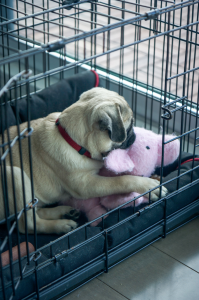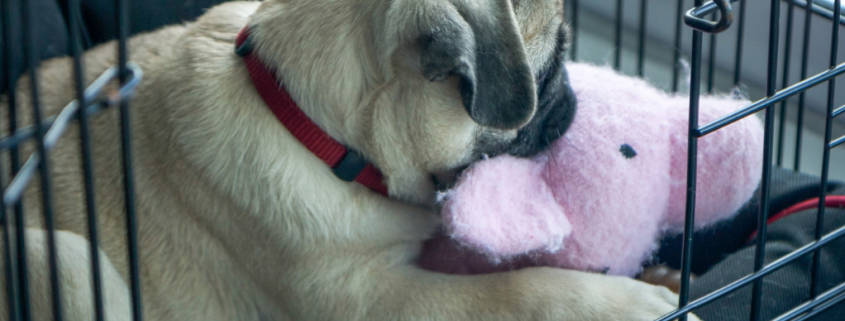Ask Crystal: Whining Puppy Woes

Dear Crystal,
So, I put my new puppy in the crate to nap and he whines for a while and then falls asleep. He will wake up to whining and all I think about is letting him out and go potty. Should I wait again until he stops crying to let him out?
Sincerely,
Whining Woes
Dear Whining,
This is a really common question with new puppies. Most people will respond with, “You shouldn’t let him out, it will teach him that whining will get him let out.” While that is true in many circumstances, the old trainer adage of “it depends” is also true. It really depends on the situation. You have to learn the difference between nuisance whining and “I really need to go out” whining.
Whether or not you respond to your puppy’s whining all depends on the timing. Always take your puppy outside to potty right before putting him in the crate. If you put your put in the crate with a Kong and as soon as he is done with the distraction, he starts whining, that is probably nuisance whining. If he is quiet for 30 minutes and then wakes up, he probably needs to go outside. Ideally, we would wait for a few minutes of quiet before letting the puppy out. If he is the type to have an accident in the crate, you may want to just wait for a few moments of quiet. Take him out to potty and then put him right back in and ignore further crying. If he didn’t go potty when outside, then you know that is not the problem.
If your pup is whining for over thirty minutes straight and seems to be amping up rather than settling down, you may need to go back some steps in your training. If you let your puppy get upset in the crate, you risk him developing a negative association with the crate.
Puppies may do better in a crate with the door open that is inside a puppy pen. If you have to leave a small puppy for longer than a one hour plus his age, you should put him in the pen rather than a crate with the door shut. Ideally, the puppy maybe cries for less than thirty minutes and then settles down.
Many puppies will do better in the crate if they are in the same room as you. Others may get upset and protest if they see you in the same room. Those pups often do better when covered with a sheet or in a quiet room by themselves.
Puppies aren’t born loving the crate. We have to teach them to love it over time with a lot of positive experiences and hopefully little to no negative experiences. When we are crate training a dog, we need to be sure the puppy is very happy at every stage before we move on to the next stage. If you follow proper procedure to condition the crate as a positive place, you can teach the puppy to remain in the crate quietly as long as their needs have been met. They should be able to communicate when they need something or are uncomfortable.
We start with allowing the puppy to go in and come out of the crate. Hide treats for them to find in the crate randomly throughout the day. Have training sessions where you toss in treats starting at the door and then slowly begin tossing them further as the puppy is comfortable. Let him come out as he wants. As you start to notice him happily going all the way in and staying in longer, work on the duration of how long he is in the crate with the door open. Always let him come out when he wants to. Then we shut the door for a moment and treat. The next step is closing the door and feeding treats inside the crate and building on that duration.
 Feeding in the crate is also a good idea to build a positive association. Place the food bowl just inside the crate with the door open and slowly over time move it further back in the crate and eventually close the door. Let the puppy out as soon as he finishes. Gradually, you can start to increase the amount of time he stays in the crate after he finishes by dropping a treat every ten seconds or so and slowly build up the time. Also, remember that puppies need to go to the bathroom after eating. You can also give him any special treats like bones only in the crate for further positive association.
Feeding in the crate is also a good idea to build a positive association. Place the food bowl just inside the crate with the door open and slowly over time move it further back in the crate and eventually close the door. Let the puppy out as soon as he finishes. Gradually, you can start to increase the amount of time he stays in the crate after he finishes by dropping a treat every ten seconds or so and slowly build up the time. Also, remember that puppies need to go to the bathroom after eating. You can also give him any special treats like bones only in the crate for further positive association.
Puppies should not be left in a crate all day. If you need to leave him in there for longer than a couple hours, put a pen with puppy pads down with the crate inside. An alternative is a puppy proof room with toys to entertain him, like a utility room or bathroom. You may also want to put an Adaptil diffuser in the room or an Adaptil collar on him. This product mimics a mother’s mammary pheromones and have been shown to help puppies sleep more quietly.
Puppies are babies and they need to feel safe. It is never wrong to comfort an upset puppy. You want him to know that you help him if he needs help. If your adult dog needed to go outside in the middle of the night to go to the bathroom or throw up, you would want him to tell you, right? If you always ignore his efforts to communicate, he may learn that it doesn’t work so he may not warn you. To give an example, I had a dog that was afraid of thunder and when it would start to thunder in the middle of the night, he would whine and pace around in his crate. You can bet I let him out. I am not going to make him feel trapped in a crate when he is scared. It had no effect on how he behaved in the crate when it wasn’t storming.
Puppies have a lot of adjustments to make when moving into a new home. They are away from their mother and siblings. They are often left alone in a new environment. Dogs are social creatures and want to be near others. The crate is not a natural place for a dog. It takes many more positive interactions to create a positive association. If he is really struggling with any amount of time in there, he probably needs more work on creating those associations. Happy training and good luck!
Until next time,
Crystal
Submit your own pet behavior question for Crystal here:







